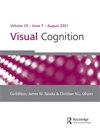Navigating meaning in the spatial layouts of comics: A cross-cultural corpus analysis
IF 1.7
4区 心理学
Q3 PSYCHOLOGY, EXPERIMENTAL
引用次数: 0
Abstract
ABSTRACT In visual narratives like comics, not only do comprehenders need to track shifts in characters, space, and time, but they do so across a spatial layout. While many scholars and comic artists have speculated about connections between meaning and layout in comics, few empirical studies have examined this relationship. We investigated whether situational changes between time, characters, or space interacted with page layouts, by looking at across-page, across-constituent, and within-constituent transitions in a corpus of 134 annotated comics from North America, Europe, and Asia. Panels shifting within constituents (e.g., while moving within a row) changed the situation the least, while those across pages and across constituents (like in a row break) had more situational changes. The boundary of a page especially aligned with changes in spatial location of the scene. In addition, discontinuous changes primarily aligned with across-page transitions. Cross-cultural analyses indicated that Asian comics convey meaning across panels in ways that are relatively less constrained by layouts, while American and European comics use the page as a unit to group and segment spatial information. Such results indicate a partial correspondence between layout and meaning, but with different cultural constraints.漫画空间布局中的语义导航:跨文化语料库分析
在像漫画这样的视觉叙事中,理解者不仅需要追踪人物、空间和时间的变化,还需要跨越空间布局。虽然许多学者和漫画艺术家都推测了漫画中的意义和布局之间的联系,但很少有实证研究考察了这种关系。我们通过观察来自北美、欧洲和亚洲的134部带注释的漫画的跨页、跨成分和成分内部的过渡,研究了时间、角色或空间之间的情景变化是否与页面布局相互作用。在组件内移动的面板(例如,在一行内移动)改变的情况最少,而跨页面和跨组件的面板(例如在一行中断中)有更多的情景变化。一页的边界,尤指随着场景空间位置的变化而对齐的边界此外,不连续的更改主要与跨页面转换对齐。跨文化分析表明,亚洲漫画以相对较少受布局限制的方式通过面板传达意义,而美国和欧洲漫画则以页面为单位对空间信息进行分组和分割。这些结果表明,布局与意义之间存在一定的对应关系,但存在不同的文化约束。
本文章由计算机程序翻译,如有差异,请以英文原文为准。
求助全文
约1分钟内获得全文
求助全文
来源期刊

VISUAL COGNITION
PSYCHOLOGY, EXPERIMENTAL-
CiteScore
4.20
自引率
10.00%
发文量
29
期刊介绍:
Visual Cognition publishes new empirical research that increases theoretical understanding of human visual cognition. Studies may be concerned with any aspect of visual cognition such as object, face, and scene recognition; visual attention and search; short-term and long-term visual memory; visual word recognition and reading; eye movement control and active vision; and visual imagery. The journal is devoted to research at the interface of visual perception and cognition and does not typically publish papers in areas of perception or psychophysics that are covered by the many publication outlets for those topics.
 求助内容:
求助内容: 应助结果提醒方式:
应助结果提醒方式:


